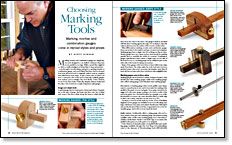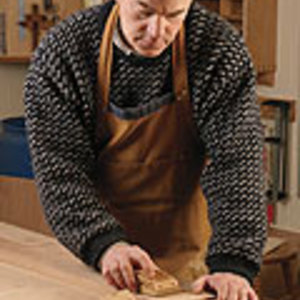All About Marking Tools

Marking and cutting gauges are simple but essential layout tools for furniture making. There are several styles, but all of these tools are used to scribe reference lines in wood, either with the grain or perpendicular to it. Gauges have wood or metal fences that slide along a beam. They use pins, wheels, or knives to do the actual cutting. Marking knives are also an important layout tool.
What Counts:
• Type of cutting tip (pin, knife or wheel)
• Ease of sharpening
• Tool size and ergonomics
Pin-style
Pin-style marking gauges are best for working with the grain — for making a line parallel to the face of a board, for example, or outlining the cheeks of a tenon. When used cross-grain, pins have a tendency to tear wood fibers and leave a rough, fuzzy line (sharpening a pin to a knife edge with a file is one way around the problem). A basic pin gauge with a wood fence and beam and a plastic locking screw costs less than $15.
Knife-style
Knife-style cutting gauges have a small blade instead of a pin, making them best for scribing lines across the grain without tearing wood fibers. Blades should be kept very sharp. These gauges may incorporate metal wear strips in the fence and cost a bit more than a single-pin marking gauge, starting at about $22. High-end versions, like the Australian made Colen Clenton, cost nearly $200.
Wheel-style
In wheel-style gauges, a small cutting disc is screwed directly into the end of the beam. Some models allow the wheel to be retracted inside the fence when it’s not being used, and the replaceable wheels are easy to sharpen. Wheels make crisp layout lines with or across the grain. A basic model from Veritas is less than $30. The Tite-Mark has a useful micro-adjust feature and costs about $80 to $90, depending on the length of the beam.
Other styles
There are also several variations. One is a combination gauge that has a single pin on one side of the beam and a pair of pins on the other. Japanese-style gauges, available for about $25, use pairs of knives and wood beams and fences to make double or single scribe lines.
Marking knives
Similar to the marking and cutting gauge, marking knives are an essential part of the layout process, especially when preparing to cut joinery by hand. A marking knife is superior to a pencil for marking layout lines. Not only is a scribed line is more permanent than a pencil line, but it is often more accurate as well. One thing to keep in mind when marking a line is that when cutting in the direction of the grain, the knife has a tendency to veer in the direction of the grain.
Fine Woodworking Recommended Products

Tite-Mark Marking Gauge

Stanley Powerlock 16-ft. tape measure

Veritas Micro-Adjust Wheel Marking Gauge






















Log in or create an account to post a comment.
Sign up Log in